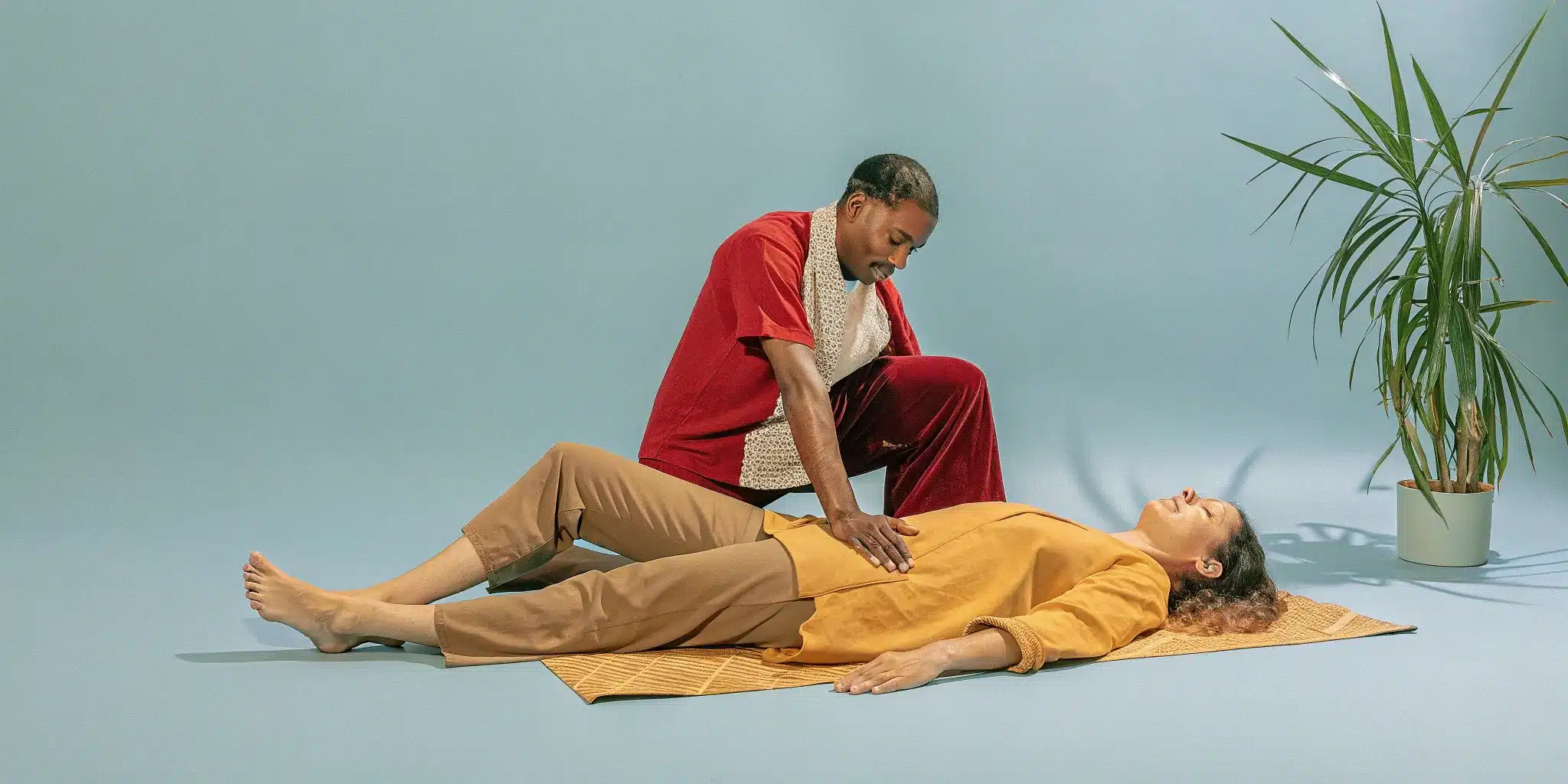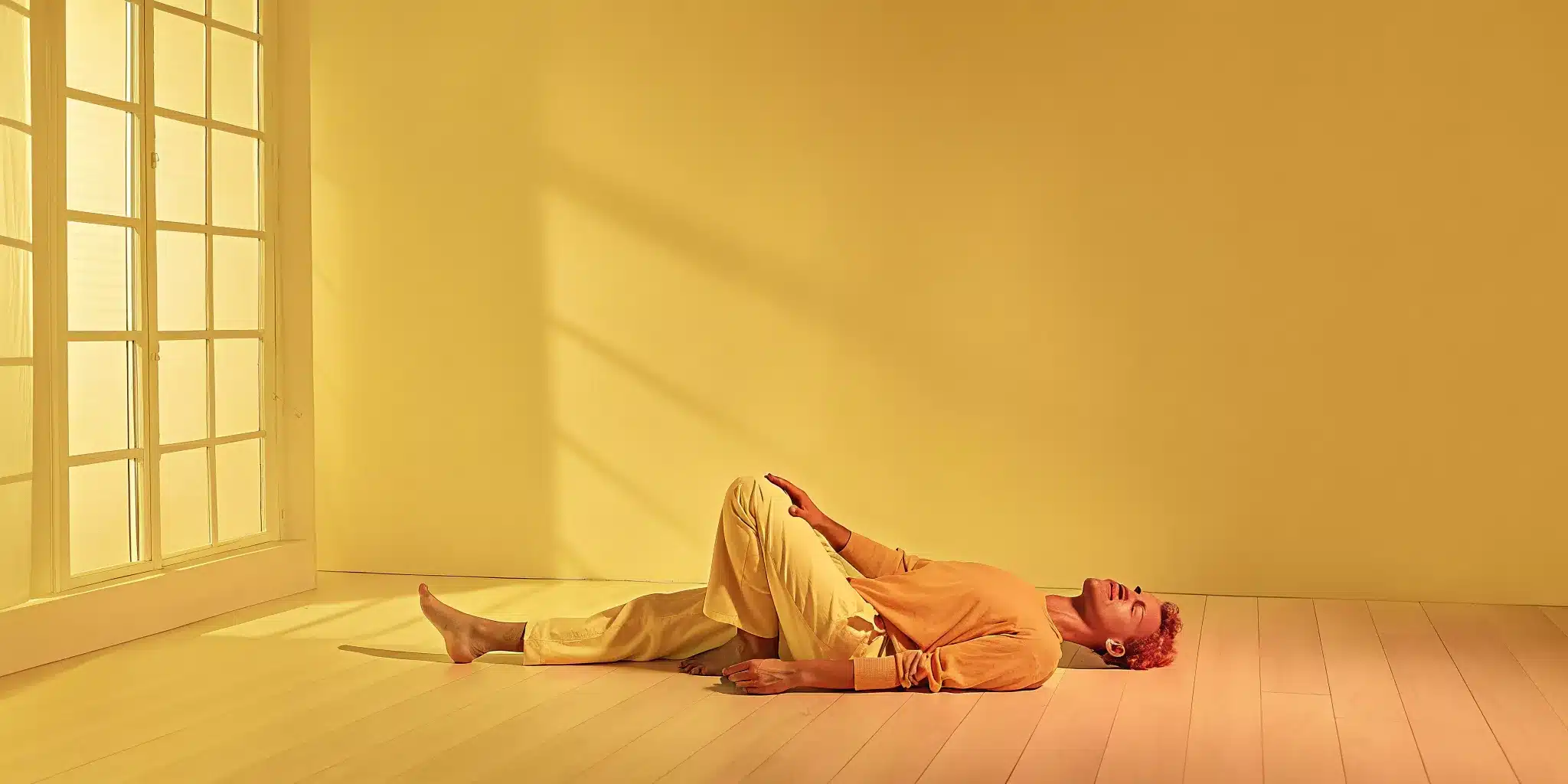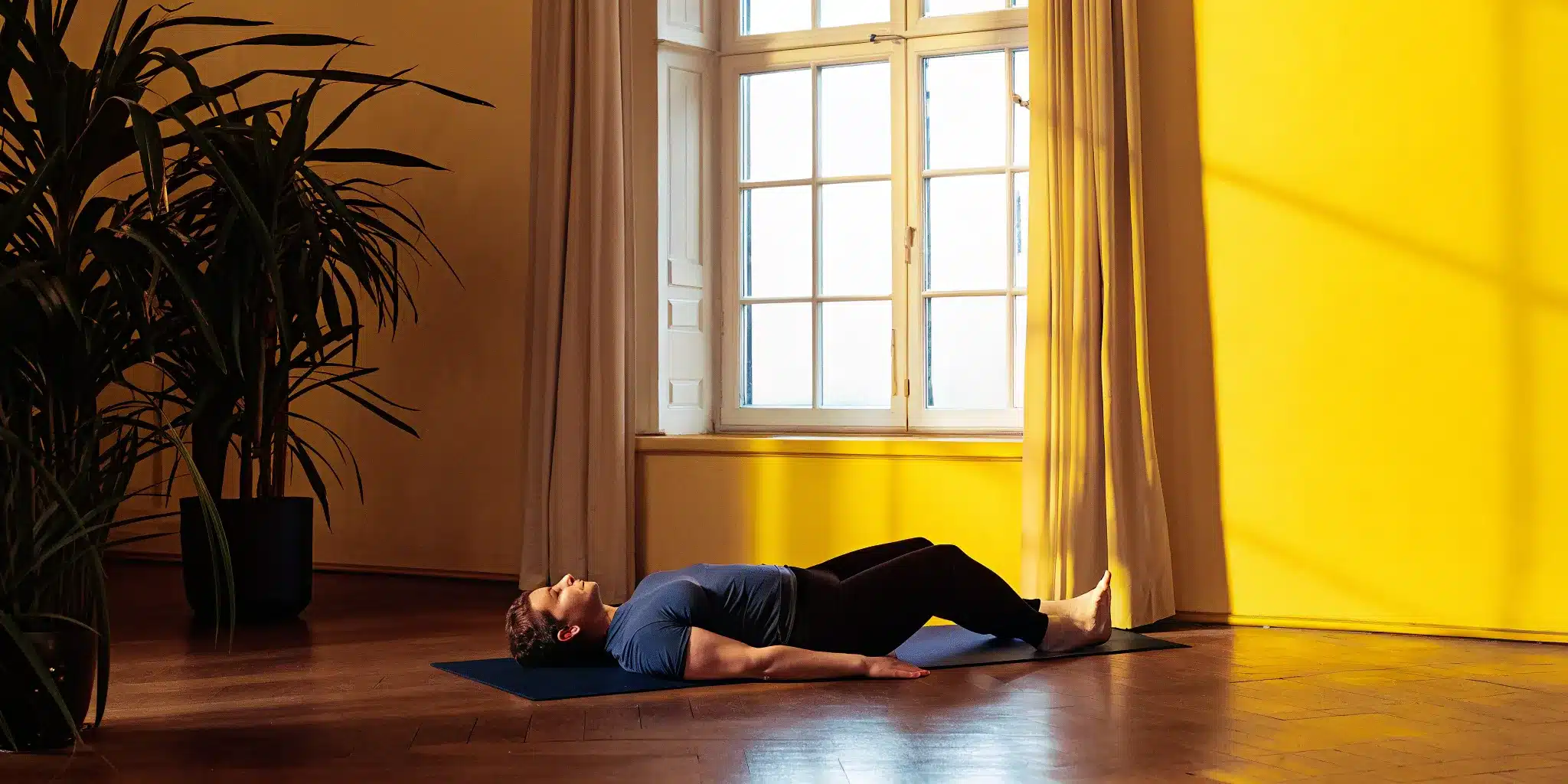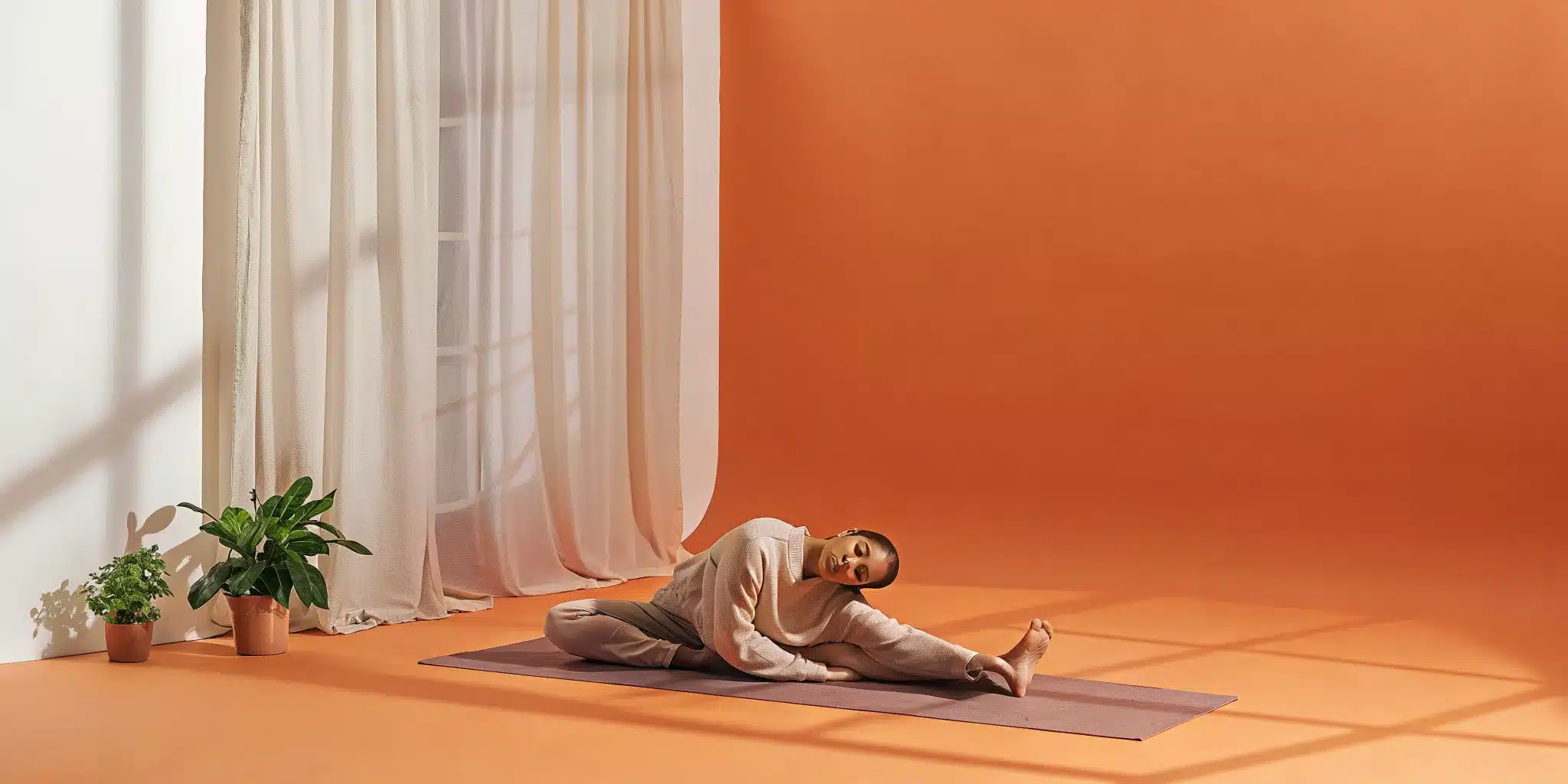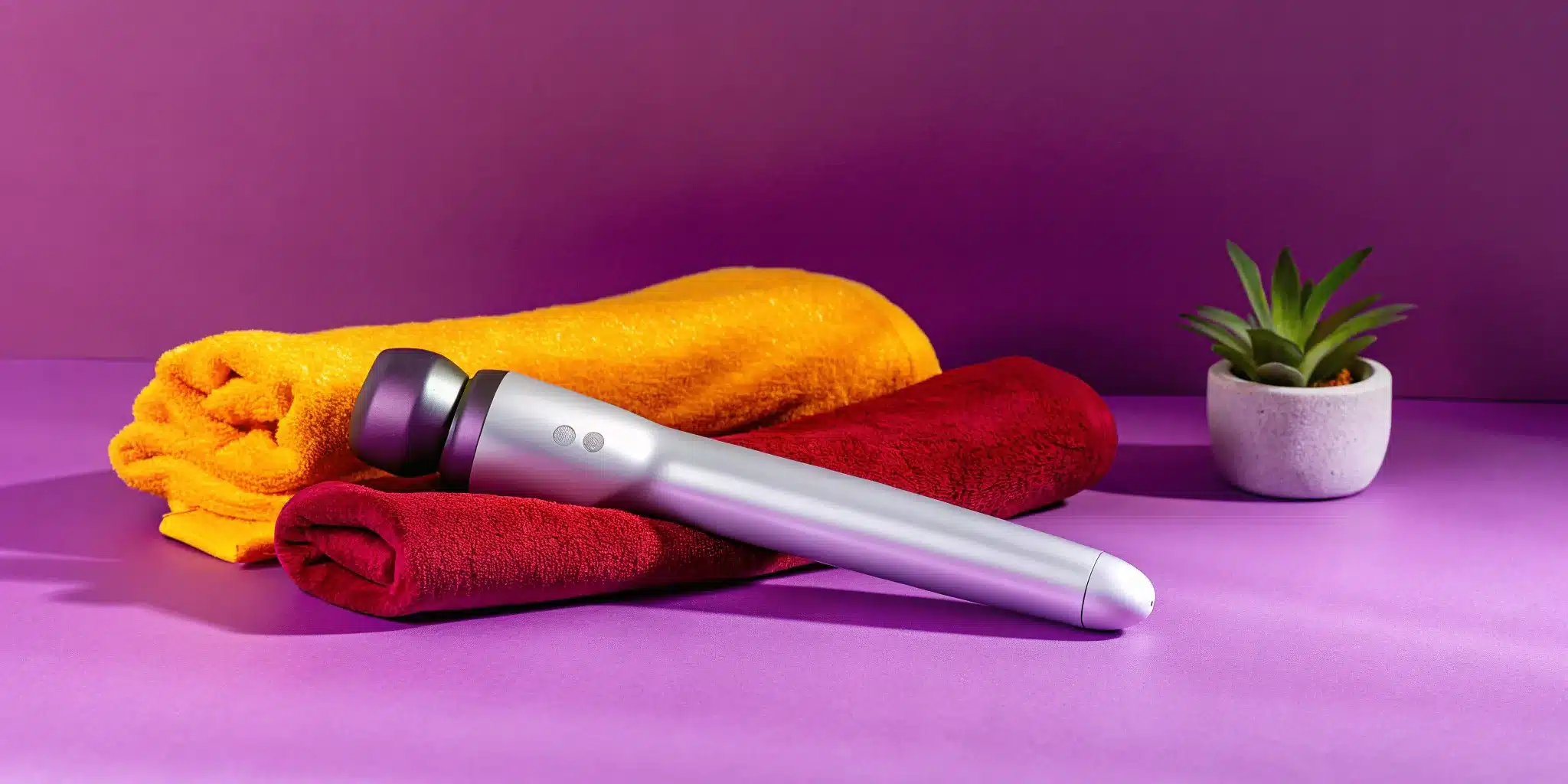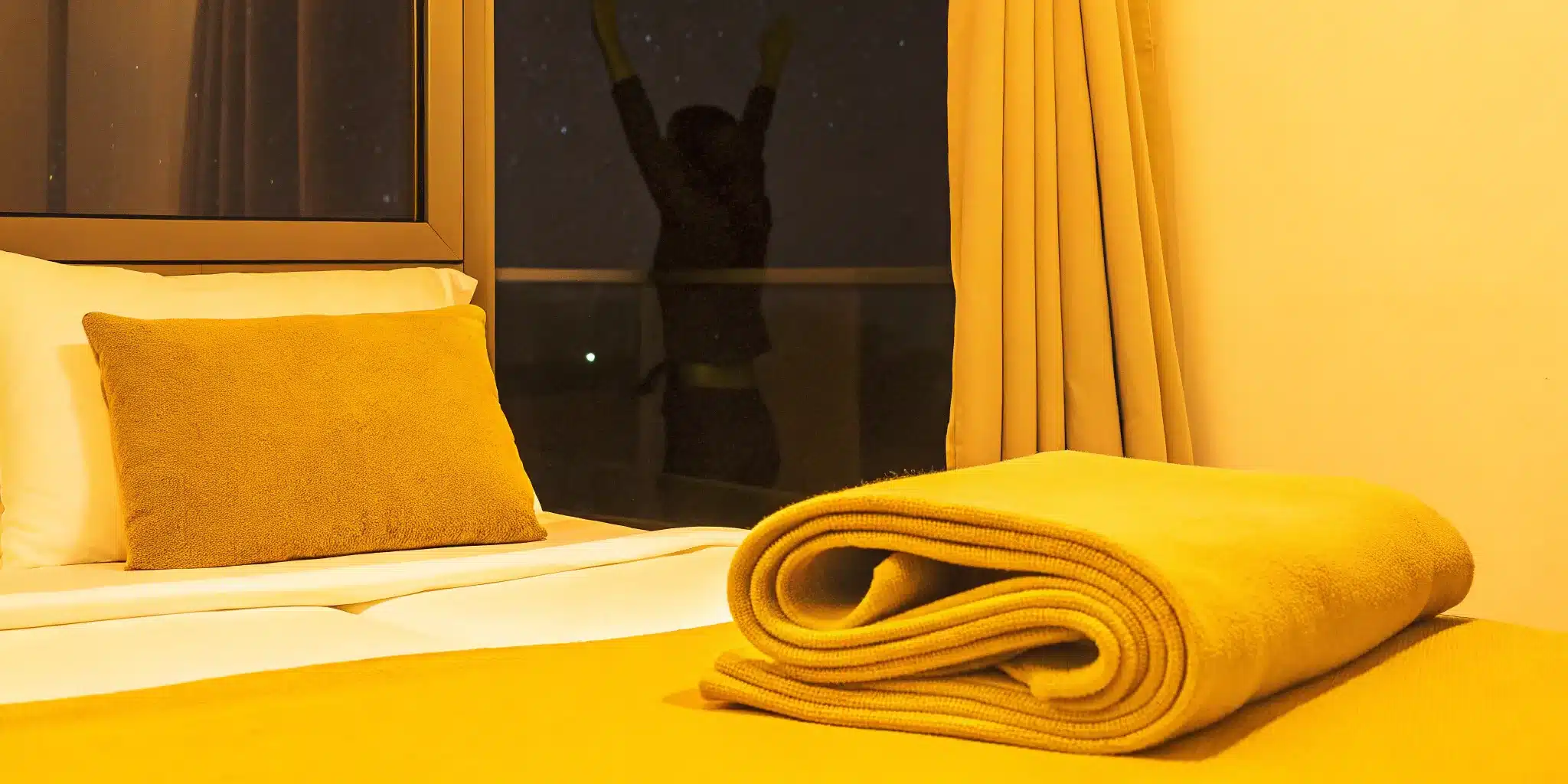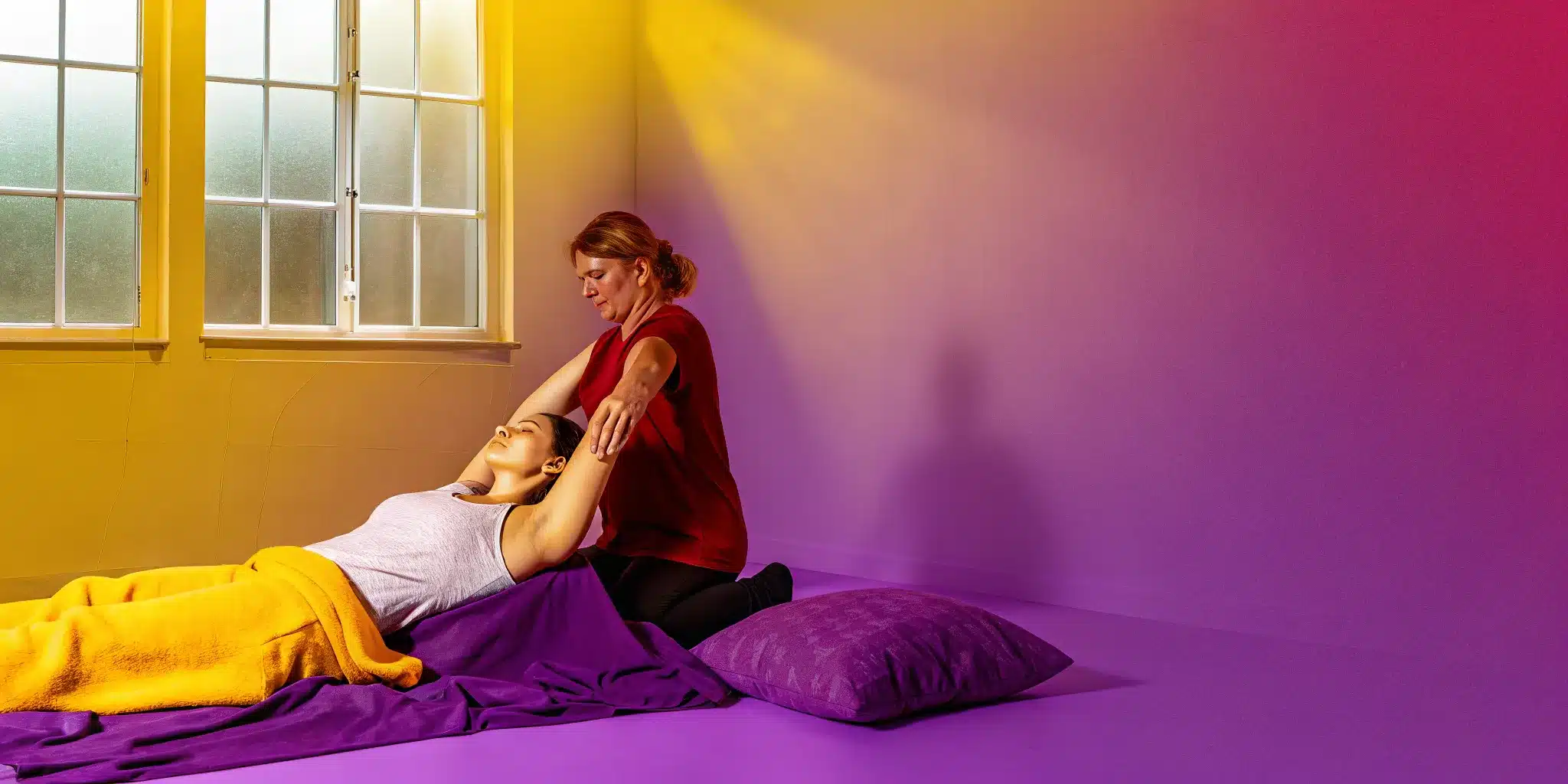That constant feeling of tightness in your neck, shoulders, or back can feel like a frustrating mystery. You might wonder why your muscles are always so tense, even on days when you haven’t done a strenuous workout. The truth is, the culprits are often hidden in your daily routine—the way you sit at your desk, how you handle stress, or even how much water you drink. To find lasting relief, you have to play detective and uncover your personal triggers. This article will help you connect the dots between your habits and your discomfort, giving you a complete toolkit for how to release chronically tight muscles and build a body that feels more resilient and free.
Key Takeaways
- Pinpoint the Root Cause of Your Tightness: Lasting relief comes from understanding why your muscles are tense. Pay attention to how daily habits like your posture, stress levels, and hydration impact your body to make targeted, effective changes.
- Layer At-Home Care with Expert Guidance: Use daily stretching and foam rolling to manage day-to-day stiffness. For a deeper release you can’t achieve alone, professional assisted stretching provides the targeted support needed to improve mobility and break the cycle of tightness.
- Create a Sustainable Prevention Plan: Staying flexible is about consistency, not intensity. Weave small habits into your routine—like short movement breaks, posture checks, and a simple stretching sequence—to maintain your results and keep chronic pain from returning.
What Causes Chronically Tight Muscles?
If you feel like you’re constantly battling stiff, achy muscles, you’re not alone. That persistent tightness that never seems to go away can be incredibly frustrating, making it hard to move freely and enjoy your day. The first step to finding relief is understanding what’s causing the problem in the first place. Often, it’s not just one thing but a combination of factors from your daily life, physical activities, and even your state of mind.
Chronically tight muscles happen when your muscles stay in a semi-contracted state for a long time. Think of it like a fist that’s always slightly clenched instead of relaxed and open. This constant tension can restrict blood flow, limit your range of motion, and lead to pain. By pinpointing the root causes—from the way you sit at your desk to how you handle stress—you can start to unwind that tension and build a plan for lasting relief.
Physical Triggers and Lifestyle Factors
Many of our daily physical habits contribute directly to muscle tightness. Things like overdoing it at the gym, recovering from an injury, or simply sitting for extended periods can cause muscles to become tense and shortened. One of the biggest culprits is poor posture. When you slouch at your desk or hunch over your phone, you force certain muscles to work overtime while others become weak. This imbalance creates a tug-of-war in your body, leading to chronic knots and stiffness in your neck, shoulders, and back. Recognizing these physical and emotional factors is key to breaking the cycle.
The Connection Between Mind and Muscle
Have you ever noticed your shoulders creeping up toward your ears when you’re stressed? That’s no coincidence. Your mind and muscles are deeply connected. When you experience stress or anxiety, your body goes into a “fight or flight” response, releasing hormones that cause your muscles to tighten up in preparation for danger. While this is helpful in a true emergency, modern-day stressors—like work deadlines or traffic—can keep your body in this tense state for far too long. Over time, this constant state of high alert can lead to chronic muscle tension, headaches, and fatigue, making it essential to find ways to manage stress for both your mental and physical well-being.
How Daily Habits Impact Your Body
The small choices you make every day add up, significantly impacting how your muscles feel. Simple things like not drinking enough water can lead to dehydration, which makes muscles more prone to cramping and tightness. Similarly, a diet lacking in key nutrients can hinder muscle repair and function. A sedentary lifestyle is another major contributor; a lack of regular movement prevents your muscles from getting the circulation and stretching they need to stay healthy. By paying closer attention to these daily habits, you can make small adjustments that support muscle health and help you release muscle tension for good.
How to Find Your Problem Areas
Before you can find relief, you need to understand what your body is telling you. Think of yourself as a detective investigating your own aches and pains. Pinpointing where the tension lives and what it feels like is the first step toward feeling better. It’s about learning to listen to the signals your body sends, whether it’s a dull ache in your lower back after a long day or a stiff neck that greets you in the morning. By paying closer attention, you can start to connect the dots between your daily habits and your discomfort, which is key to creating a plan that actually works.
Common Signs of Muscle Tension
Muscle tension isn’t always a sharp, obvious pain. Sometimes it’s a constant, low-grade ache, a feeling of being “stuck,” or a noticeable lack of flexibility when you try to move. You might feel like your shoulders are permanently glued to your ears or that your hips are locked in place. These sensations often stem from a mix of physical and emotional factors. Poor posture from sitting at a desk, for example, is a huge contributor to chronic tightness in the neck and back. Stress also plays a major role, causing us to unconsciously clench our muscles without even realizing it. Recognizing these subtle signs is the first clue to finding your problem areas.
Where Does It Hurt? The Most Affected Muscles
Take a moment to scan your body. Where do you hold the most tension? For many of us, the usual suspects are the neck, shoulders, and lower back, thanks to hours spent hunched over screens. Your hips and hamstrings might also be screaming for attention, especially if you sit for long periods or are very active without enough recovery. Many things can make your muscles tight, including overuse from exercise, a previous injury, or even just being still for too long. Identifying these specific muscle groups helps you target your efforts, whether you’re stretching at home or seeking professional help.
Red Flags You Shouldn’t Ignore
While most muscle tightness can be managed with stretching and lifestyle changes, it’s important to know when to see a doctor. If your muscle stiffness lasts for more than a few days and doesn’t improve with gentle movement or rest, it’s time to get it checked out. Pay close attention if the stiffness is accompanied by other symptoms like a fever, significant muscle weakness, swelling, a stiff neck, or chest pain. These can be signs of an underlying infection or a more serious condition that needs medical attention. Your safety comes first, so don’t hesitate to consult a healthcare professional if something feels off.
At-Home Techniques for Muscle Relief
Finding relief from persistent muscle tightness doesn’t always require leaving your house. You can create a solid foundation for better movement and less pain with a few simple, consistent practices. These techniques can help you manage day-to-day discomfort and are a great complement to professional care. Think of them as your personal toolkit for releasing tension whenever you need it.
Stretches That Actually Work
When your muscles feel constantly tight, the thought of stretching might seem daunting. But you don’t need to twist yourself into a pretzel to feel a difference. The key is consistency. Regularly holding gentle stretches can gradually decrease stiffness over time. Practices like yoga are fantastic because they combine stretching with movement, which can improve flexibility and may help ease chronic back and neck pain. Focus on the major muscle groups connected to your problem areas. Hold each stretch for 30 seconds without bouncing, and remember to breathe. It’s about coaxing the muscle to relax, not forcing it.
Self-Massage and Pressure Points
You have the power to soothe your own sore muscles right at your fingertips. Massage is a direct way to address muscle pain and tension, and even a quick 20-minute session can make a difference. You can use your hands to apply gentle strokes, knead tight spots, or gently tap on an area to encourage relaxation. For hard-to-reach places like your back or shoulders, a tennis ball or a lacrosse ball can be a great tool. Simply place it between your body and a wall or the floor and gently roll over the tender spots. This approach helps you apply targeted pressure to release knots and calm irritated muscles.
How to Use a Foam Roller
A foam roller can be one of your best allies in the fight against muscle tightness. Think of it as a way to give yourself a deep tissue massage. Foam rolling helps break up adhesions, or “knots,” in your muscles and fascia, improving blood flow and releasing tension. For the best results, try stretching a muscle group for a few minutes and then foam rolling it. When you roll, move slowly and deliberately. When you find a particularly tender spot, pause on it for about 30 seconds while taking deep breaths. This combination of stretching and foam rolling can be incredibly effective for releasing stubborn tightness in your legs, hips, and back.
Using Your Breath to Relax
It might sound too simple, but how you breathe has a direct impact on your muscle tension. When you’re stressed or in pain, you tend to take shallow, rapid breaths, which keeps your nervous system in a state of high alert. This, in turn, tells your muscles to stay tight and ready for action. By consciously shifting to deep, slow breathing, you can send a signal to your brain that it’s safe to relax. Try this: place one hand on your belly, and as you inhale slowly through your nose, feel your belly expand. Exhale slowly through your mouth. Focusing on these deep breathing exercises can help calm your entire system and release the unconscious tension you’re holding in your body.
When to Get Professional Help
Trying to manage tight muscles on your own is a great first step, but sometimes it’s just not enough. If you’ve been stretching and foam rolling with little to no relief, it might be time to call in a professional. Getting expert help can provide deeper, more lasting relief and address the root cause of your discomfort. A trained professional can see things you can’t, ensuring you’re using the correct techniques to finally get the relief you deserve. From assisted stretching to physical therapy, there are several paths you can take when your body is asking for more support. Understanding your options is the best way to choose the right one for your specific needs and get back to moving comfortably.
The Power of Assisted Stretching
If you want to relieve chronic muscle tightness effectively, professional stretch therapy is one of the best options available. During an assisted stretching session, a trained therapist guides your body through a series of stretches. This one-on-one approach ensures you use the proper form and get a much deeper stretch than you could achieve alone. The therapist can isolate specific muscles and gently push past your usual range of motion, helping to release long-held tension and improve your flexibility over time. It’s a targeted way to loosen up and feel better without the guesswork.
What to Expect from Physical Therapy
When tight muscles are part of a bigger issue, a physical therapist can be a huge help. They do more than just stretch you; they diagnose the underlying problems causing your pain, like muscle imbalances, weakness, or poor posture. A physical therapist will create a personalized plan to not only stretch tight muscles but also strengthen weak ones. The goal of physical therapy is to reduce your pain, help your body move correctly, and prevent the problem from coming back, making it a great option for long-term recovery and health.
Finding the Right Massage
Massage is a fantastic tool for immediate relief from muscle pain and tension. A good massage therapist can work out knots and tight spots, promoting relaxation and blood flow to the affected areas. Even a quick 20-minute session can make a noticeable difference in how your muscles feel. There are many types of massage, from gentle Swedish massage for overall relaxation to deep tissue massage for targeting specific problem areas. You can get a professional massage or even try some self-massage techniques at home to keep your muscles feeling loose between appointments.
Knowing It’s Time for an Expert
So, how do you know when it’s time to make that call? If your muscle tightness isn’t getting better with home care, or if it’s getting worse, that’s a clear sign. You should also see a doctor if your pain is severe or if you have other symptoms like numbness, tingling, or weakness. A doctor can properly diagnose the cause of your muscle tightness and create a treatment plan. They might also refer you to a specialist, like a physical therapist or stretch therapist, to ensure you get the specific care you need to move and feel better.
Move Better with the Right Exercises
Once you’ve started to release some of that built-up tension, the next step is to introduce gentle movement. The right kind of exercise doesn’t just make you stronger; it helps your muscles learn to work together correctly, providing better support for your entire body and preventing tightness from returning. Think of it as building a resilient foundation that helps you move through your day with more ease and less pain. It’s all about finding a balance between flexibility and strength to keep your body feeling its best.
Start Exercising Safely
Jumping into a new exercise routine without preparation can do more harm than good, especially when your muscles are already tight. The most important first step is to always warm up. A good warm-up gradually increases your heart rate and blood flow to your muscles, making them more pliable and ready for activity. This could be as simple as five to ten minutes of brisk walking or light jogging. After warming up, you can move into your stretches. To enhance your flexibility and reduce your risk of injury, hold each stretch for about 15-30 seconds without bouncing. Listen to your body and never push into sharp pain.
Strengthen Your Muscles for Better Support
Stretching is fantastic for relief, but strengthening is what creates long-term stability. When certain muscles are weak, others have to overcompensate, which is a common cause of chronic tightness. By building strength in key areas like your core, glutes, and back, you create a natural support system for your body. This helps distribute your weight and physical stress more evenly. Combining stretching with tools like a foam roller can be a great way to release muscle tension before you begin strengthening exercises. This two-part approach ensures your muscles are both flexible and strong enough to support you properly.
Smart Recovery Techniques
How you recover is just as important as the exercise itself. While stretching on your own is beneficial, sometimes you need a little help to get the deep release your body craves. This is where professional stretch therapy can make a huge difference. During an assisted stretching session, a trained therapist can guide your body into stretches that are difficult or impossible to achieve on your own. They understand how to work with your body to safely increase your range of motion, which can significantly reduce discomfort and improve your overall mobility. It’s a smart, targeted way to accelerate your recovery and feel better, faster.
Fuel Your Body: The Role of Diet and Water
You can’t build a strong house with poor materials, and the same goes for your body. What you eat and drink plays a huge role in your muscle health. Dehydration is a major contributor to muscle stiffness and cramping, so make sure you’re drinking plenty of water throughout the day, especially if you’re active. Proper muscle function relies on good hydration and a balanced diet rich in nutrients like magnesium and potassium. Think of water as the oil that keeps your body’s engine running smoothly. Supporting your muscles from the inside out is a simple yet powerful way to complement your stretching and exercise routine.
Build Healthier Habits
Releasing tight muscles is a great first step, but keeping them that way requires building a lifestyle that supports your body. Think of these as small, daily investments in your long-term comfort and mobility. By making a few conscious adjustments to your routine, you can prevent chronic tightness from returning and help your body feel its best every single day. It’s not about a complete overhaul, but rather about creating a foundation of healthy habits that work for you.
Improve Your Posture
Think about how you’re sitting or standing right now. Are your shoulders slumped forward? Is your head jutting out? Poor posture puts constant, unnecessary strain on your muscles and joints, which is a major cause of chronic tightness. The goal is to align your body properly to reduce that load. Try to sit or stand tall, with your shoulders relaxed back and down, your core gently engaged, and your head balanced over your spine. Making a conscious effort to check in with your posture throughout the day can make a huge difference in preventing muscle tightness before it even starts.
Set Up an Ergonomic Workspace
If you spend hours at a desk, your workspace setup can either help or hurt your body. An ergonomic workspace is designed to fit you, minimizing physical stress. Start by adjusting your chair so your feet are flat on the floor and your knees are at a 90-degree angle. Your monitor should be at eye level to prevent you from hunching over, and your keyboard should be positioned so your wrists can stay straight. These simple adjustments promote good posture and can significantly reduce the neck, shoulder, and back pain that comes from a poorly arranged desk.
Get Better Sleep for Muscle Recovery
Sleep is when your body does its most important repair work. If you’re not getting enough quality rest, your muscles don’t have the chance to fully recover from the day’s activities, leading to increased tension and stiffness. Prioritizing sleep is one of the best things you can do for your muscles. Try to establish a consistent sleep schedule, even on weekends. Create a relaxing bedtime routine, like reading a book or taking a warm bath, and make sure your bedroom is dark, quiet, and cool. Quality sleep is essential for effective muscle recovery and overall well-being.
Simple Ways to Manage Stress
Ever notice your shoulders creeping up toward your ears when you’re stressed? That’s your body’s physical response to mental and emotional pressure. Chronic stress leads to chronically tight muscles. Finding healthy ways to manage stress is key to breaking this cycle. Simple practices like deep breathing exercises, meditation, or even a short walk can help alleviate muscle tension. For deep-seated tension, professional stretch therapy is an incredibly effective way to release the physical grip that stress has on your body.
Create a Long-Term Prevention Plan
Finding relief from chronically tight muscles is a huge win, but keeping them from coming back is the real goal. This is where a long-term prevention plan comes in. It’s not about adding a bunch of complicated tasks to your day. Instead, it’s about creating small, sustainable habits that keep your body feeling good. By weaving simple practices into your daily life, you can maintain your mobility, reduce the risk of future pain, and stay ahead of muscle tension before it becomes a problem. Think of it as ongoing maintenance for your body—a little effort each day goes a long way in preventing stiffness and discomfort down the road.
Weave Movement into Your Day
One of the best ways to prevent muscles from seizing up is to keep them moving. You don’t need an intense workout regimen; gentle, consistent activity is incredibly effective. Simple things like taking a daily walk, going for a swim, or riding a bike can significantly improve circulation and keep your muscles loose and flexible. These activities naturally incorporate movements that stretch and engage different muscle groups. The key is consistency. Making movement a non-negotiable part of your daily routine helps release chronically tight muscles and prevents them from tensing up in the first place. Find an activity you genuinely enjoy, and it will feel less like a chore and more like a welcome break.
How to Check In with Your Body
Your body is constantly sending you signals, and learning to listen to them is a powerful prevention tool. Make a habit of checking in with yourself throughout the day. Do you feel your shoulders creeping up toward your ears while you work? Is your lower back starting to ache after sitting for a while? When you notice these early signs of tension, you can address them immediately with a quick stretch or a posture adjustment. This regular self-assessment helps you catch potential issues before they escalate into chronic pain. Understanding the common causes of muscle stiffness can also help you identify which daily habits might be contributing to your discomfort, allowing you to make targeted changes.
Your Go-To Maintenance Routine
A dedicated maintenance routine is your secret weapon against muscle tightness. This doesn’t have to take hours—just 10 to 15 minutes a day can make a world of difference. Your routine should include a few key stretching techniques that target your personal problem areas. Hold each stretch for about 15–30 seconds to give the muscle time to relax and lengthen. You can also incorporate tools like a foam roller to work out deeper knots. For more targeted and effective relief, consider adding professional assisted stretching to your routine. Consistency is what transforms these actions into lasting results, making your muscles more resilient and less prone to stiffness over time.
Related Articles
- How to Improve Mobility After 60: A Complete Guide – STRETCHMED
- 10 Benefits of Stretching: Feel & Move Better – STRETCHMED
- Stretch 3 Times a Day? Benefits & Safety Guide – STRETCHMED
Frequently Asked Questions
Why are my muscles still tight even though I stretch regularly? This is a common frustration, and it often comes down to a few things. You might be stretching the right muscle in the wrong way, or you might not be holding the stretch long enough for the muscle to truly release. More often than not, the tight muscle is actually overworking to compensate for another muscle that’s weak. In that case, stretching alone won’t solve the problem. You need to combine stretching with strengthening exercises to create better balance in your body.
What’s the difference between normal muscle soreness and chronic tightness? Think of it this way: normal muscle soreness from a workout, often called DOMS, feels like a dull ache that shows up a day or two after exercise and fades within a few days. It’s a sign your muscles are repairing and getting stronger. Chronic tightness, on the other hand, is a persistent feeling of stiffness, restriction, or being “stuck.” It doesn’t go away with a few days of rest and can be present even when you haven’t been active.
Can I fix my tight muscles with just at-home techniques? You can absolutely make a significant impact with consistent at-home care like stretching, foam rolling, and improving your daily habits. These are the foundation for long-term relief. However, if your tightness is severe or has been around for a long time, professional help can be a game-changer. A trained therapist can provide a deeper, more targeted release through methods like assisted stretching and help you identify the root cause of the problem, which is often difficult to do on your own.
How long will it take to find relief from chronic muscle tightness? There isn’t a magic timeline, as it really depends on how long you’ve been experiencing the tightness and what’s causing it. The key is consistency. You’ll likely start to feel some improvement within a few weeks of dedicated, daily effort. The goal isn’t a quick fix but a gradual release. By consistently applying the right techniques and building healthier habits, you’re teaching your body a new, more relaxed way of being.
Besides stretching, what’s the single most important habit to prevent muscle tightness? If you have to pick just one thing, focus on incorporating more movement into your day. Many of us spend hours sitting, which causes muscles in our hips and back to shorten and tighten. You don’t need to schedule an extra workout; just make a conscious effort to break up long periods of stillness. Get up every hour to walk around, do a few simple posture checks, or take the stairs. Consistent, gentle movement keeps your muscles pliable and prevents them from getting stuck in one position.

